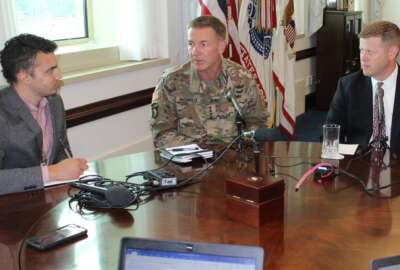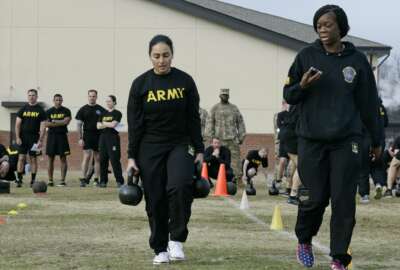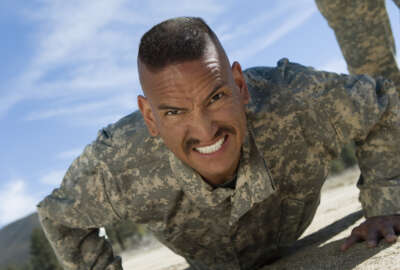
National Guard testing new Army fitness exam, getting soldiers ready for year-round deployments
The National Guard is assessing and fielding the Army's new fitness test.
Most soldiers don’t have to worry about the new fitness test until sometime between October and late 2020, but there are some National Guard soldiers who are already sweating it out to the new physical assessment.
The National Guard has seven battalions working with Army Training and Doctrine Command to assess and field the developing Army Combat Fitness Test (ACFT) before it’s rolled out to the full Army. It’s also serving as a way to keep soldiers in shape year round.
“This changes the physical fitness culture and with the ACFT, it’s key for the Army National Guard because everyone is mentioning the combat fight, but we also have a homeland security mission where it can pop up at any given time,” said National Guard Command Sgt. Maj. John Sampa told Federal News Network. “When the solider is out there fighting fires or wading through water or trying to lift people into trucks and rescue folks from danger; that’s physically demanding at any point of the year for Army National Guard soldiers.”
The Guard is also acting as a guinea pig for the Army as whole by evaluating the impacts of the test on soldiers. The new test is supposed to be more comprehensive, multidomain-focused, less injurious and more gender inclusive. The test is supposed to have 80% predictability on how a soldier will do in his or her job or in combat.
“It’s been a positive reaction from the soldiers,” Sampa said. “There are a lot of unknowns because the soldiers are not as familiar with the test itself. Being involved and talking to soldiers who are part of the fielding, it’s a positive outcome. They are highly motivated when they are taking the test and they are excited. It’s very interactive for the soldier. This test, from my own witness, builds camaraderie.”
The test isn’t just keeping soldiers fit, it’s serving a larger purpose of caring for soldiers in 2019 as opposed to the 1900s.
“The ACFT is part of the much larger concept, which is total fitness,” said Brig. Gen. Richard Johnson, leader of the Guard’s training directorate. “Things like nutrition and the overall mental, spiritual, physical health of the soldiers. Those are the things being emphasized. We think this test brings a much broader look at your overall health to include things like prevention of injury. The Army is looking at the total picture to help support readiness. Soldiers need to be fit for life first and then they are, in turn, fit for whatever rigors they would need to go through.”
The Army has put more emphasis on reducing injuries since the Defense Department signed out policy that states service members who are nondeployable for more than a year can be separated from the military. At one point, 15 percent of soldiers were nondeployable. That number has since dropped to about 6 percent.
Reducing injuries also falls into the statements made by Army Chief of Staff nominee Gen. James McConville last week as he explained that soldiers don’t want to be treated as disposable cogs in a machine and treating them that way adversely affects retention and recruitment.
“What I find is the young men and women today want to be part of something bigger than themselves, they want to make sure that they matter, they don’t see themselves as interchangeable parts in an industrial-age system” he said during his confirmation hearing. “Part of what we are trying to do now is implement a 21st century talent management system that recognizes every person in the Army for their unique talents.”
The Army also wanted the ACFT to prepare soldiers for the future threats the service plans to face as near-peer competition becomes the norm. The Army is no longer only operating in the Middle East as it has for the last 18 years.
“The concept of a soldier having to operate in a multidomain environment; we see a tremendous stress in that environment,” Johnson said. “We’ve got to be able to multitask. The simplicity with which you might see a soldier’s skills if you look backwards in the Army; those things are still important. But if you take that same soldiers with that same skillset and put him into an environment that has all of these inputs; all of these sensors around you, where you have to deal with multiple environments, things are different. It’s not just the physical ground you’re on, but the virtual environment. The digitization of our equipment, the lethality of our equipment, the speed in which information flows and the enemy has the same capability. A fitter soldier is more capable of handling a more stressful environment.”
So what’s in the test?
- A dead lift between 140 pounds and 340 pounds
- Throwing a ten-pound medicine ball overhead and backward
- Doing as many hand-release pushups as possible in two minutes
- A sprint-drag-carry
- As many sit ups hanging from a bar as possible in two minutes
- Finally, a two-mile run in under 20 minutes
Start practicing. The test is coming.
Copyright © 2024 Federal News Network. All rights reserved. This website is not intended for users located within the European Economic Area.
Scott Maucione is a defense reporter for Federal News Network and reports on human capital, workforce and the Defense Department at-large.
Follow @smaucioneWFED
Related Stories





